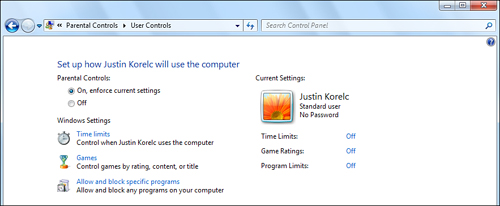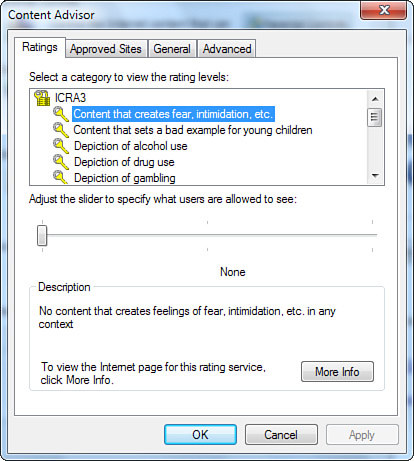4. Controlling Objectionable Content
The
Web holds the most diverse range of information and content of any
library in the world. That diverse range includes a great deal of
material that you might deem objectionable, and there is no perfect way
of protecting yourself from it—short of never going online. However, IE
incorporates two features, called Parental Controls and the Content
Advisor, to help you screen out many of the things you or the other
people using your computer would rather not see.
Parental Controls
Parental
Controls is a new feature, introduced in IE7, that remains in IE8. If
your children often use your computer and you don’t want them seeing
some material on the Web, or even using a certain program, you can set
up Parental Controls to block access to those websites.
You
must set up a System Recovery Account password before you can use
Parental Controls. The System Recovery Account is an administrator
account that is built into Windows 7, in case problems arise with your
account. “Troubleshooting and Repairing Problems.” However, this account
password serves a second purpose: You can use the password to disable
Parental Controls. Without this password, any user on your computer can
disable Parental Controls.
After
you set up the System Recovery Account password, click the user picture
or name in the list to set up Parental Controls for that user. The User
Controls window allows you to enable Parental Controls, as shown in Figure 7.

In
this window, you can also collect information about the user’s activity
on your computer; determine the websites, games, and other programs you
don’t want the user to access; and control how long the user can use
the computer.
The Content Advisor
The
Content Advisor evaluates web content based on a rating system. The
included rating system was originally developed by RSACi (Recreational
Software Advisory Council on the Internet) and is now handled by the
Internet Content Rating Association (ICRA), but you can add other
rating systems, if you want.
You must
manually enable the Content Advisor, but after it is set up, you can
password-protect the Advisor so that only you can adjust the settings.
To enable the Content Advisor, open the Internet Options dialog box and
do the following:
1. | Click
the Content tab and click Enable to open the Content Advisor dialog
box. (You may be asked to allow this operation via the familiar User
Account Control dialog box.)
|
2. | The Content Advisor dialog box contains four tabs, as shown in Figure 8. On the Ratings tab, you can move the slider to set a rating level in each of the categories presented.

|
3. | Click
the Approved Sites tab. List specific websites here to control access
to them. Click Always to make it easily acceptable, or click Never to
restrict access.
|
4. | On
the General tab, choose whether unrated sites can be viewed. Keep in
mind that many objectionable sites will not be rated. You can also set
a password to let users view unrated or restricted sites on a
case-by-case basis, or you can add another rating system here.
|
5. | Click
the Advanced tab. If you plan to use a ratings bureau or PICSRules file
that you obtain from the Internet, your ISP, or another source, add it
here. Click OK when you’re finished.
|
RSACi
and other organizations provide content-rating systems based on the
Platform for Internet Content Selection (PICS) system developed by the
World Wide Web Consortium, or W3C (www.w3.org/PICS).
The systems work by using metatags in the code of a web page. The tags
are usually generated by the rating organization after a site developer
follows a brief rating procedure. Developers can then place the PICS
metatag in the header of their HTML code, where it is identified by
IE’s Content Advisor when you try to open the page. The tag identifies
the types and levels of content contained in the site, and the Content
Advisor allows or disallows the site based on the content settings you
have chosen. If you want to screen websites using a system other than
RSACi’s, you must install an appropriate PICSRules file provided by the
rating organization.
Of course,
rating is voluntary. Developers set the rating levels in the metatags
based on their own evaluation of the site content, so you don’t get a
surefire guarantee that the tag accurately represents the site. RSACi
periodically audits rated sites, and web developers generally try
to rate their sites as accurately as possible. Because it is a
voluntary system, providing inaccurate ratings defeats the purpose.